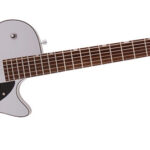Guitar action refers to the height of your guitar strings above the fretboard. It’s a crucial aspect of guitar setup that significantly impacts playability and sound. For beginners and experienced players alike, understanding Action Guitar is key to enjoying your instrument to the fullest. While the quick answer is often to aim for the lowest possible action without fret buzz, the reality is more nuanced. There are pros and cons to both higher and lower action, and the ideal setup often depends on the type of guitar you play and your personal playing style.
The Benefits and Drawbacks of Higher Action
A higher action, meaning the strings are further from the fretboard, offers some distinct advantages, especially for certain playing styles.
Advantages of High Action
One key benefit is reduced fret buzz. With more space for the strings to vibrate freely, you can strike the strings harder without them hitting the frets and creating that unwanted buzzing sound. This is particularly useful for players who have a heavier strumming or picking hand. Furthermore, a higher action can contribute to a fuller, richer tone. It allows for techniques where you can strike the string in a way that maximizes its vibration, not just up and down, but also “forward-and-back”. This enhanced vibration resonates more powerfully through the guitar’s soundboard, resulting in a more resonant and dynamic sound. A prime example is the apoyando or rest-stroke technique common in classical guitar, where the controlled string release benefits from the extra space provided by a higher action to produce a richer tone.
Disadvantages of High Action
However, a high action isn’t without its downsides. The most immediate is the increased effort required from your fretting hand. You have to press the strings down harder to reach the fretboard, which can lead to faster fatigue, hand strain, and sore fingertips, especially during longer playing sessions. Additionally, higher action can affect intonation. As the strings are further from the frets, pressing them down stretches them more significantly. This increased string stretch can make notes, particularly when playing higher up the neck, sound slightly sharp.
Exploring the Advantages and Disadvantages of Lower Action
Conversely, a lower action, where the strings are closer to the fretboard, offers a different set of advantages and disadvantages.
Advantages of Low Action
A lower action is often favored for its playability. Techniques like hammer-ons and pull-offs (legato) become significantly easier and smoother to execute, requiring less finger strength and movement. Generally, with less pressure needed to fret notes, you can achieve faster playing speeds and play with less overall effort. This makes playing more fluid and less physically demanding, which is beneficial for fast passages and intricate musical pieces.
Disadvantages of Low Action
Despite the ease of play, a very low action can also present challenges. String bending can become more difficult. With less space between the strings and the fretboard, your fingers might encounter resistance from adjacent strings while trying to bend. The most common problem with a low action is fret buzz. Because the strings are closer to the frets, they are more prone to vibrating against them, especially if you play aggressively. This can result in a buzzing or rattling sound that detracts from the clarity and sustain of your notes.
When Action Becomes Problematic: Too High or Too Low
It’s important to recognize when guitar action becomes excessively high or low, as either extreme can severely hinder playability.
If the action is excessively high, it can become nearly impossible to press the strings down with enough force to make proper contact with the frets, especially further up the neck. This makes playing uncomfortable and frustrating, if not impossible.
Conversely, if the action is extremely low, you might encounter situations where fretting a note at a specific fret doesn’t produce the intended pitch. For instance, when fretting at the 4th fret, the string might also touch the 5th fret due to the extremely low action, causing the 5th fret note to sound instead. This issue can sometimes be mistaken for uneven frets, highlighting the importance of considering action as a potential cause before assuming fret problems. Worn or uneven frets can also contribute to action problems and may necessitate a fret dress or refret.
Factors Influencing Guitar Action
Achieving optimal guitar action involves adjusting several components of your instrument. Key factors include:
- Saddle and Bridge Height: Adjusting the height of the saddles at the bridge is a primary way to raise or lower the action.
- Neck Curvature (Relief): The truss rod within the guitar neck controls its curvature. Adjusting the truss rod can change the neck relief, which in turn affects the action.
- Nut Height: The nut, located at the headstock end of the fretboard, also plays a role in string height, particularly for open strings and the first few frets.
Furthermore, different types of guitars are typically set up with different action heights. Classical and steel-string acoustic guitars generally have a higher action compared to electric guitars. This is partly due to the thicker strings often used on acoustic instruments and the playing styles commonly employed, which often involve more forceful strumming or fingerpicking. However, personal preference, string gauge, and playing style are paramount. A player who uses light gauge strings and a gentle touch on an acoustic guitar might prefer a lower action, while someone who plays aggressively with heavier strings on an electric guitar might benefit from a slightly higher action.
Finding Your Ideal Action Guitar
Ultimately, the “best” action guitar setup is subjective and depends on your individual needs and preferences. Experimenting with different action heights and considering your playing style, guitar type, and comfort level is crucial. Understanding the interplay between action and playability will empower you to optimize your guitar setup for the best possible playing experience.

